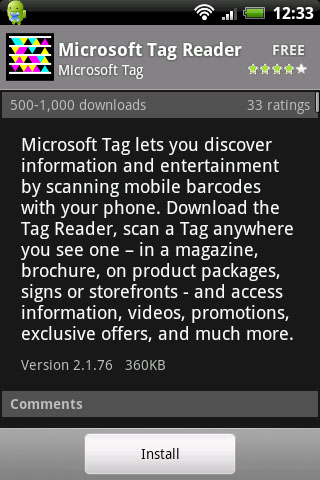
Software giant Microsoft has, oddly enough, released its first application for Android smartphones: a version of its Tag program that enables users to snap pictures of Microsoft’s digital barcodes. The idea behind tags is to provide an easy way for phone users to get a URL that can take them to more information about products, services, events, or other things just by snapping a picture of the printed or displayed “Tag” with their smartphone. The technology saves typing and avoids the hassle of trying to type in a URL using a phone.
Android users can get the Tag app via the Android Market or by pointing their mobile browser to gettag.mobi.
However, lest Android users think they’re somehow special for getting a version of Tag for their platform, slow down: Microsoft has also released Tag applications for Symbian, BlackBerry devices, J2ME, and (yes) the iPhone.
Microsoft”s Tag technology is an implementation of two-dimensional barcodes that can carry more information than standard 2D barcodes by using triangles instead of squares and a palette of four to eight colors—it has a capacity of about 13 bytes. Tags aren’t really intended to replace traditional barcodes, but instead to provide a way for consumers to quickly consumers to connect to online content, whether that be additional information, special offers, a map to a particular location, or a myriad of other users. Tags are also more appealing to print advertisers than standard 2D barcodes because they can take up less space and can be more easily integrated visually into a variety of material.
Editors' Recommendations
- How to find your phone number on iPhone or Android
- The best Android tablets in 2024: the 11 best ones you can buy
- AirTags range: here’s how far the tracker can reach
- This Android phone is a surprisingly great buy at $100
- The most common Skype problems and how to fix them


